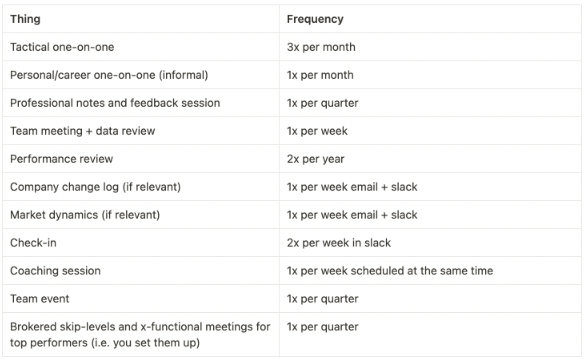Already on Rhythm?




Every organization has their own communication heartbeat. It’s part of the employee experience and dictates how they’ll receive information from the company, as well as how they’ll give information back to the company. This rhythm doesn’t happen on its own. Leaders have to be proactive with sustaining their heartbeat, they need to be thoughtful about what’s said and when for their employees.
The term communication heartbeat was coined by Patty McCord, the former Head of People at Netflix:
“How do you know when people are well enough informed? Here’s my measure. If you stop any employee, at any level of the company, in the break room or the elevator and ask what are the five most important things the company is working on for the next six months, that person should be able to tell you, rapid fire, one, two, three, four, five, ideally using the same words you’ve used in your communications to the staff and, if they’re really good, in the same order. If not, the heartbeat isn’t strong enough yet.”
Your communication cadence will operate on different rhythms. Each rhythm will define what type of employee touchpoint is going to happen, when it will happen, how frequently it’s needed, and what information will be included. For example, employees might have a tactical 1:1 three times a month with their manager plus a once monthly personal catch up to discuss their career path.
Your job as a frontline manager is to be the keeper of the heartbeat for all your employees. Instead of being a reactivity machine that only responds to requests as they come up, be proactive. Make sure that your team is on the same page, has a shared purpose, and knows what’s going on in the company as a whole. The very best managers are disciplined and precise about their heartbeat.
Here’s an example of a good communication heartbeat cadence:

There has never been an employee that complains about too much communication from their company. If you feel like you’re communicating too much, you’re actually communicating just enough. Every time you share information, 80% of it is lost so you need to share over and over again to get your point across. This is especially true in remote or hybrid office environments.
Each role and team has their own cadence. Some people, like new hires, will have more frequent check-ins. During their first 3 months as a new hire to the team, they should have an even more frequent communication cadence.
The communication heartbeat for the entire organization should look something like this:
For the sales department you might use a communication cadence like this:
At the team level your cadence can include:
Finally, for each individual rep, your communication heartbeat should include:
When these communication heartbeat cadences happen on schedule, employees will always know what’s going on. They’ll know when it's appropriate to talk about certain things, like their career progression, instead of wondering when to bring up certain topics. Knowing the schedule in advance eases the burden of deciding when to speak up.
It’s easy to build out your company heartbeat but much harder to maintain it. Without a keeper of the heartbeat, communication will fall apart after a few months. You’ll have a lot more situations where leaders say “we’re going to do all these great things” but nothing actually happens.
Ideally, the people department will be the keeper of the heartbeat. Most of the time though it's the head of each department who beats the drum. The keeper must constantly reiterate just how important communication is to the success of the organization. They control information flowing down, up, and across in a systematic way. If someone new joins the team, the keeper needs to add them to the right heartbeat.
You might be wondering if your company’s communication heartbeat is in need of some first aid. Here are a few signs that you’re not communicating enough:
Communication is a central part of running a successful sales team. To learn more about how to make your conversations even more impactful, check out our post on how to communicate with evidence.